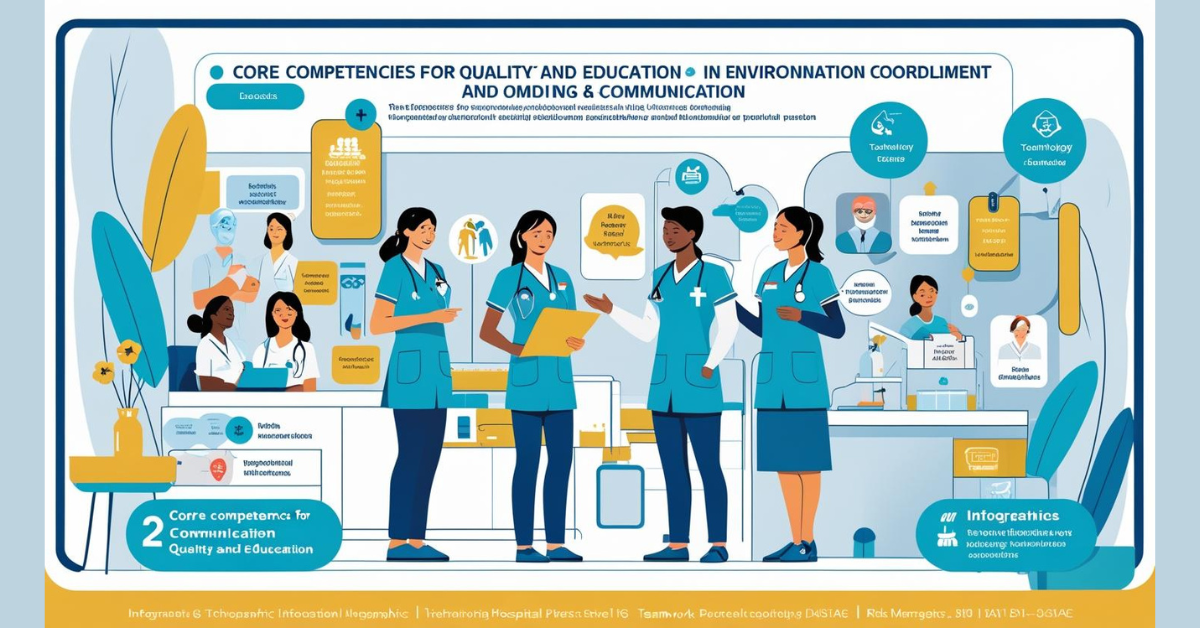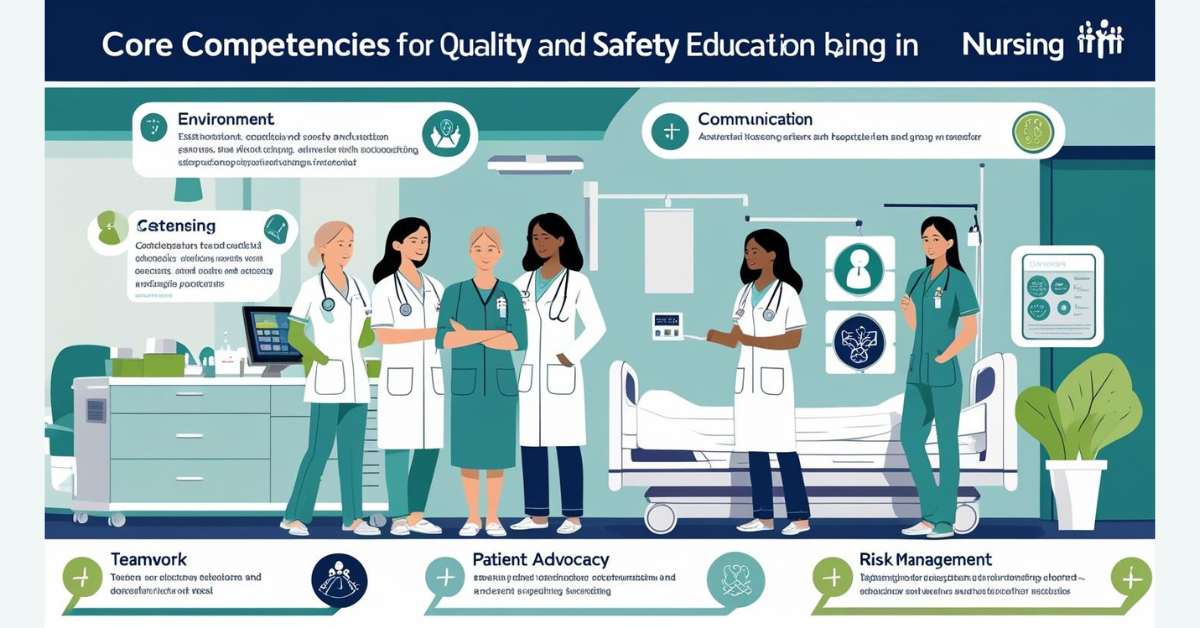The Nurses Core Competencies for Quality And Safety Education As Environment Coordination Communication. An essential nursing competency is the ability to provide care that meets patients’ needs through logical reasoning and precise nursing skills. The nursing competency framework includes four competencies: the ability to understand needs, the ability to provide care, and the ability to collaborate.
Environment Coordination Communication As Nurses Core Competencies for Quality And Safety Education
The Quality and Safety Education for Nurses (QSE) competency, which the nurse addresses by sending email reminders to the community about vaccinations and regular diabetes screening, is “patient-centered care.”
This resource library is organized according to the International Council of Nurses (ICN) Core Competencies in Disaster Nursing. The competencies are divided into eight areas: Preparedness and Planning, Communication, Emergency Management Systems, Safety, Assessment, Intervention, Recovery, and Law and Ethics.
Optimal Healing Environment
In the book, Notes on Nursing by Elizabeth J. Murray: What It Is and What It Is Not, Florence Nightingale (1860; republished 1969) emphasizes the importance of the environment in what she calls the “reparative process.” She describes nursing as more than “the administration of medicines and the application of poultices” (p. 8) and suggests that nurses should also focus on “proper use of fresh air, light, warmth, cleanliness, quiet, and the proper selection and administration of diet” (p. 8).
Nightingale also recognized that there are times when nurses cannot control the environment in which they deliver care. She notes that “bad sanitary, bad architectural, and bad administrative arrangements often make it impossible to nurse” (p. 8). In essence, what she was describing was how to create an optimal healing environment. Who knew that more than 150 years later, the basic principles identified by Nightingale would re-emerge as critical in the healing process and to establishing an environment essential to patient-centered care? Florence Nightingale was clearly a nurse ahead of her time.
An optimal healing environment is an environment that “supports and stimulates patient healing by addressing the social, psychological, physical, spiritual, and behavioral components of healthcare and enabling the body’s capacity to heal itself” (Samueli Institute, 2014, para. 2). Patient-centered care must be delivered in an environment that fosters healing; is safe and clean; guards patients’ privacy; engages all the human senses with color, texture, artwork, music, aromatherapy, views of nature, and comfortable lighting; and considers the experience of the body, mind, and spirit of all who use the facility (Frampton et al., 2008, p. 170).
Space is provided for loved ones to congregate and for peaceful contemplation, meditation, or prayer. “At the heart of the environment of care, however, are the human interactions that occur within the physical structure to calm, comfort and support those who inhabit it. Together the design, aesthetics, and these interactions can transform an institutional, impersonal, and alien setting into one that is truly healing” (Frampton et al., 2008, p. 170).
Teamwork and Collaboration
Nurses and other health-care professionals cannot work in a silo. Working in interdisciplinary teams requires a shift in the health-care culture from one of individual experts to a cooperative and collaborative team environment. Team members integrate expertise and optimize care for patients. The IOM defines work in interdisciplinary teams as follows: “cooperate, collaborate, communicate, and integrate care in teams to ensure that care is continuous and reliable” (Greiner & Knebel, 2003, p. 45).
Although often used interchangeably, the terms interdisciplinary, multidisciplinary, and inter-professional do not mean the same thing. Multidisciplinary describes a team in which members function independently and then share information with each other (McCallin, 2001). Nurses are very accustomed to working with and within multidisciplinary teams. However, the IOM is calling for individ ual team members to be more involved with collaboration, coordination, and contribution to the team goals—in other words, not just sharing with team members.
Currently, the term inter-professional is gaining popularity because it is more inclusive of all members of the health-care team. Interprofessional refers to members with specific disciplinary training and diverse perspectives working collaboratively in planning and implementing patient-centered care (Interprofessional Education Collaborative Expert Panel, 2011). The skills related to this competency identified by the IOM include the following (Greiner & Knebel, 2003, p. 56):
- Learn about other team members’ expertise, background, knowledge, and values.
- Learn individual roles and processes required to work collaboratively.
- Demonstrate basic group skills, including communication, negotiation, delegation, time management, and assessment of group dynamics.
- Ensure that accurate and timely information reaches those who need it at the appropriate time.
- Customize care and manage smooth transitions across settings and over time, even when the team members are in entirely different physical locations.
- Coordinate and integrate care processes to ensure excellence, continuity, and reliability of the care provided.
- Resolve conflicts with other members of the team.
- Communicate with other members of the team in a shared language, even when the members are in entirely different physical locations.
With the increasing complexity of care today necessary to keep pace with the dynamic needs of patients, inter-professional teams are critical. In the truest form, teamwork focuses on patient-centered care, transcends individual and discipline specific needs, and generates a positive synergy that results in an advanced level of performance that would not have been possible if team members worked alone. Interdisciplinary or inter-professional teamwork results in enhanced quality of care, improved patient outcomes, and maximized resources (Galt & Paschal, 2011).
Although health-care professionals may approach collaboration from different world views, certain characteristics are shared, such as coordination, communication, and teamwork (Disch, 2012). Safe and quality care requires teamwork and collaboration among all team members as well as the patient and family. The definition of the nursing core competency of teamwork and collaboration is to “function effectively within nursing and inter-professional teams, fostering open communication, mutual respect, and shared decision-making to achieve quality patient care” (Cronenwett et al., 2007, p. 125).
Delivering patient-centered care requires health-care professionals to become excellent team players (Inter-professional Education Collaborative Expert Panel, 2011). Teamwork involves integrating the knowledge, expertise, and experience of health-care professionals to perform collaboratively in planning and delivering patient-centered care that is safe, timely, efficient, effective, and equitable (Inter-professional Education Collaborative Expert Panel, 2011).
Functioning as an effective team member requires nurses to collaborate with other team members, patients, and families, by using available evidence to inform shared decision making and problem solving. Professional nursing’s scope of practice is dynamic, often overlapping the practice of other health-care professionals, and requires cooperation and sharing of knowledge and ideas to deliver safe, quality care (ANA, 2010a).
In addition, nurses collaborate with patients and families to assess, plan, implement, and evaluate safe and quality care (ANA, 2010a). Nurses are called to actively promote collaborative care planning to ensure availability and accessibility of quality health care to all persons who need it (ANA, 2015a). The fundamental elements of teamwork and collaboration include care coordination and communication.
Care Coordination
Nurse leaders and managers as well as all nurses coordinate care delivery as members of inter-professional and inter-professional teams. Care coordination is a priority area needed for health-care quality improvement (Adams & Corrigan, 2003). Various organizations such as the National Quality Forum (NQF), the Agency for Healthcare Research and Quality (AHRQ), and the ANA are embracing its application to various patient care settings.
The major goal of care coordination is “to establish and support a continuous healing relationship, enabled by an integrated clinical environment and characterized by the proactive delivery of evidence-based care and follow-up” (Adams & Corrigan, 2003, p. 49). The NQF (2006) defines care coordination as a “function that helps ensure that the patient’s needs and preferences for health services and information sharing across people, functions, and sites are met over time” (p. 1).
The AHRQ describes it as “the deliberate organization of patient care activities between two or more participants (including the patient) involved in a patient’s care to facilitate the appropriate delivery of health-care services. Organizing care involves the marshaling of personnel and other resources needed to carry out all required patient care activities, and is often managed by the exchange of information among participants responsible for different aspects of care” (McDonald et al., 2007, p. 41).
The ANA identifies patient-centered care coordination as part of the independent scope of practice and a core professional standard and competency for all registered nurses (ANA, 2014). The ANA (2012) describes care coordination as “ensuring that a patient’s needs and preferences for health services and information are communicated and delivered effectively among healthcare providers, functions, and settings over time” (p. 16).
More specifically, care coordination includes organizing the components of the plan of care, coordinating the implementation of the plan of care, advocating for the delivery of dignified and holistic care, and documenting the coordination of care (ANA, 2015b). The ANA’s (2015a) Code of Ethics for Nurses With Interpretive Statements establishes a primary commitment to the patient and the family and requires nurses to ensure the plan of care reflects the patient’s wishes and individuality. In addition, nurse leaders and managers should work to ensure that the relevant parties are involved and have a voice in decision making about patient care issues (ANA, 2015a).
Communication
Communication is a key aspect of teamwork and collaboration. It involves communicating with patients, families, and other health-care professionals by using effective techniques and tools. Communication, whether verbal or nonverbal, should be sensitive, responsive, understandable (i.e., avoiding discipline-specific jargon), and, most importantly, effective (Interprofessional Education Collaborative Expert Panel, 2011). Effective communication is accurate and timely and enhances quality of care. Additionally, effective communication requires listening actively, encouraging input from others, and respecting opinions of all team members.
There is a critical link between effective communication and patient safety. All aspects of patient care hinge on how health-care professionals, patients, and families interpret available information (Schuster & Nykolyn, 2010). Inter-professional and inter-professional (made up of all nurses) team members make health-care decisions based on information communicated among all team members with input from patients and their families.
Miscommunication and gaps in communication can jeopardize patient safety. The Joint Commission (TJC, 2015) cites communication errors as a leading cause of medical errors. Nurses need to create an atmosphere in which patients and their families feel valued, like an important part of the health-care team, and comfortable sharing personal information (Schuster & Nykolyn, 2010).
Read More:
https://nurseseducator.com/didactic-and-dialectic-teaching-rationale-for-team-based-learning/
https://nurseseducator.com/high-fidelity-simulation-use-in-nursing-education/
First NCLEX Exam Center In Pakistan From Lahore (Mall of Lahore) to the Global Nursing
Categories of Journals: W, X, Y and Z Category Journal In Nursing Education
AI in Healthcare Content Creation: A Double-Edged Sword and Scary
Social Links:
https://www.facebook.com/nurseseducator/
https://www.instagram.com/nurseseducator/
https://www.pinterest.com/NursesEducator/
https://www.linkedin.com/in/nurseseducator/
https://www.researchgate.net/profile/Afza-Lal-Din
https://scholar.google.com/citations?hl=en&user=F0XY9vQAAAAJ



whoah this blog is great i love reading your articles. Keep up the good work! You know, lots of people are hunting around for this information, you can aid them greatly.